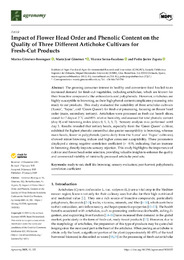Por favor, use este identificador para citar o enlazar este ítem:
https://hdl.handle.net/11000/38013Registro completo de metadatos
| Campo DC | Valor | Lengua/Idioma |
|---|---|---|
| dc.contributor.author | Giménez-Berenguer, Marina | - |
| dc.contributor.author | Giménez, María José | - |
| dc.contributor.author | Serna-Escolano, Vicente | - |
| dc.contributor.author | Zapata, Pedro Javier | - |
| dc.contributor.other | Departamentos de la UMH::Tecnología Agroalimentaria | es_ES |
| dc.date.accessioned | 2025-11-10T12:13:49Z | - |
| dc.date.available | 2025-11-10T12:13:49Z | - |
| dc.date.created | 2025-01-27 | - |
| dc.identifier.citation | Agronomy 2025, 15(2), 322 | es_ES |
| dc.identifier.issn | 2073-4395 | - |
| dc.identifier.uri | https://hdl.handle.net/11000/38013 | - |
| dc.description.abstract | The growing consumer interest in healthy and convenient food has led to an increased demand for fresh-cut vegetables, including artichokes, which are known for their bioactive compounds like antioxidants and polyphenols. However, artichokes are highly susceptible to browning, as their high phenol content complicates processing into ready-to-eat products. This study evaluated the suitability of three artichoke cultivars (‘Lorca’, ‘Tupac’, and ‘Green Queen’) for fresh-cut processing, focusing on flower head order (main, secondary, tertiary). Artichokes were processed as fresh-cut hearth slices, stored for 7 days at 2 ◦C and 85% relative humidity, and assessed for total phenolic content (day 0) and browning index (days 0, 1, 3, 5, 7). Sensory analysis was performed until day 3. Results revealed that tertiary heads, especially from the ‘Green Queen’ cultivar, exhibited the highest phenolic content but also greater susceptibility to browning, whereas main heads, lower in polyphenols (particularly from the ‘Lorca’ and ‘Tupac’ cultivars), showed minor browning indices and higher consumer acceptability. These parameters displayed a strong negative correlation coefficient (>−0.9), indicating that an increase in browning directly impacts sensory rejection. This study highlights the importance of cultivar and flower head order selection, providing valuable insights to | es_ES |
| dc.format | application/pdf | es_ES |
| dc.format.extent | 18 | es_ES |
| dc.language.iso | eng | es_ES |
| dc.publisher | MDPI | es_ES |
| dc.rights | info:eu-repo/semantics/openAccess | es_ES |
| dc.rights.uri | http://creativecommons.org/licenses/by-nc-nd/4.0/ | * |
| dc.subject | ready-to-eat | es_ES |
| dc.subject | shelf life | es_ES |
| dc.subject | browning | es_ES |
| dc.subject | sensory evaluation | es_ES |
| dc.subject | post-harvest | es_ES |
| dc.subject | polyphenols | es_ES |
| dc.subject | correlation coefficient | es_ES |
| dc.subject.other | CDU::6 - Ciencias aplicadas | es_ES |
| dc.title | Impact of Flower Head Order and Phenolic Content on the Quality of Three Different Artichoke Cultivars for Fresh-Cut Products | es_ES |
| dc.type | info:eu-repo/semantics/article | es_ES |
| dc.relation.publisherversion | https://doi.org/10.3390/agronomy15020322 | es_ES |

Ver/Abrir:
agronomy-15-00322-v2.pdf
9,7 MB
Adobe PDF
Compartir:
 La licencia se describe como: Atribución-NonComercial-NoDerivada 4.0 Internacional.
La licencia se describe como: Atribución-NonComercial-NoDerivada 4.0 Internacional.
.png)